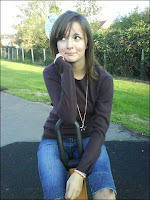The Opening Titles
Black background (establishing the dark, mysterious atmosphere for the rest of the film) small blue font (blue is a connotation of cold, eery, death). The colour of the text gets darker and fades, leaving an eery glow. The titles are seen immediately, getting straight to point.
Generic Themes
The opening sequence is shown in reverse which added interest and intrigue, instantly grabbing the audience's attention. The murder is shown, then it goes back in time to before the killing. This creates a sense of inevitability because you know the end point before you have seen the full story. This is a good way of creating tension and suspense in a Thriller film.
Sound
Diegetic~ any diegetic sounds (such as the sound of a polaroid shaking or the sound of the gun) are heightened to make them louder and more intense.
Non-Diegetic~ orchestral music is played over the opening sequence, it is slow and builds & falls to create an uneven atmosphere. There is also a voiceover from the main character. At times he is in shot but not actually speaking, creating the idea that the audience is seeing what thoughts are running through his mind.
Mise-en-scene
~The contrast between dark and light is heightened
~Camera is established as a key object in the scene (which becomes more relevant as the film goes on)
~Black and white is used to show the character's confusion and disorientation
~He is seen in a hotel room, suggesting something about his lifestyle
~The fast-paced opening sequence and the use of a gun link to a Thriller/Action sub-genre
~Photograph is unclear and blurred, drawing the audience in. Just as you think you can see it, the photo fades further
~Characters wear relatively smart clothing
Shot Types
*Lots of closeups
*POV extreme closeup
*focus is on the photo for a long time (unusual to have a close up of one thing for such a long time)
*CUs are used to disorientate and confuse
*High and low angle shots are used to change perspective, This reverses the audience's position from a place of power to a place of vulnerability in a matter of seconds
*Medium long shot used in the next scene to show more of his environment (less intense atmosphere, more normal and naturalistic than previous shots)
Camera Movement
No camera movement to begin with- an unusual device (most films use lots of movement to create tension whereas Nolan uses stillness, combined with other conventions, to build an atmosphere in this opening).
After this, a tilt and a pan are used to more of the situation gradually.
I liked this Thriller opening. I was really inspired by the use of black and white because it was aesthetically interesting and symbolic. I also liked the variation of the narrative structure- flashbacks used, not a linear sequence of events.




